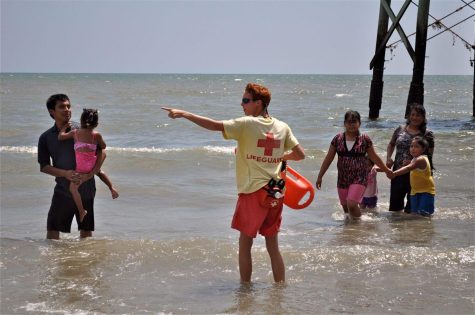Isle of Palms Lifeguarding
What to know and where to apply.
Are you a swimmer? Runner? Athlete? Do you love spending time on the beach? Or helping other people? If you answered yes to any of these, you may be perfect for a position as an Isle of Palms County Park Lifeguard. The IOPCP is looking for more lifeguards this summer and I highly recommend joining. Lifeguarding requires hard work, problem solving ability, and patience. Just one summer on the beach will instill these traits in anyone. I have been a lifeguard since last May and have learned so much since then. It has been the best job I’ve ever had. Many Charleston beach goers see us spend hours on the beach, but few people truly understand what happens throughout the work day of lifeguards. In this article, I will give you a full 8:30am-6:30pm overview of the job:
8:30- Every morning, one lifeguard must arrive early to set up for the day. They load the John Deere Gator (a utility vehicle) with everything needed for the day in the garage. This includes medical equipment, paddle boards, a kayak, cans (floating rescue devices), buoys, flags, radios, and a water cooler. This equipment is brought down to the beach and is loaded onto the lifeguard stands.
8:50- The rest of the lifeguards arrive and clock in.
9:00- Morning training begins. The supervisor decides between running, swimming, rescue training, medical training, calisthenics, or any combination of these.
10:00- First sit begins. Two lifeguards must be sitting on the stand for the first ‘sit’ of the day on the stand.
One sit lasts 45 minutes. The lifeguard must be alert and scanning the water at all times. They can have food and water, but must be ready to respond to an emergency at a moment’s notice. The guards that are not on stand are “break guards” but must be training or helping the guards for the 45 minutes. There is also a “rover” who walks across the beach, surveying the entire beach and the water. The rotation between sits, breaks, and rovers continues every 45 minutes throughout the rest of the day.
1:00-1:45 or 1:45-2:30- Guards choose to eat lunch during one of their breaks. Lunch break is fully paid because guards must respond to emergencies at any moment. Lunch is usually eaten in the air conditioned break room, with a refrigerator and complimentary popsicles.
6:00- Lifeguards close the beach. Equipment is gathered, driven back to the garage, and rinsed off.
6:30- Lifeguards log their training for the day.
≈6:45- Lifeguards clock out and leave for the day.

Now that you have a better understanding of a day in the life of a lifeguard, I will share a few tips and comments for first-year guards.
- If there is one word to describe working on the beach, it would be ‘sandy’. To avoid being coated in sand at every moment throughout the day, dry off with a towel as often as possible. Let sunscreen dry before running or sitting on the sand. Take advantage of the public showers during your break. Being sand-free and salt-free is a luxury.
- Reapply sunscreen. Especially early in the season, it is easy to burn when spending 9-10 hours on the beach. Reapplying is necessary to prevent burns, although my skin is much more tolerant once I get a tan later in the season.
- Buy decent sunglasses. Sunglasses are worn all day, every day. If your glasses are uncomfortable, not dark enough, or fall off your face when running, it may be time to buy a nice pair of sunglasses. They last longer, feel better, look nicer, and can save your eyes from the sun. (P.S. Lifeguards get a discount from hobieeyewear.com)
- At the beginning of the year, lifeguards get to choose uniform clothing from the year. In my opinion, here are the best possible choices: Swim trunks- More comfortable, shorter, and more stylish than board shorts. One long sleeve and one short sleeve shirt- Long sleeves block sun better, but can be uncomfortable on very hot days. Choosing both for different days is optimal.
- Buy a very large water bottle. Filling up your water frequently can be annoying, and it may surprise you how much water you drink during the 45 minutes on stand.
- Do snack research. Snacks are your best friend on the beach. Hard work burns calories so it is necessary to stockpile some goodies for the day. I have gotten great recommendations from coworkers, but the best strategy for finding good snacks is to peruse the aisles of your favorite grocery store. (Bottled chocolate milk is a delicious and nutritious beach beverage)
- Train hard. Being the slowest swimmer, runner, or paddler is not fun. Everyone has the potential to be the fastest so put in the work.

If lifeguarding interests you, click this link for more information for more information or to submit an application:








